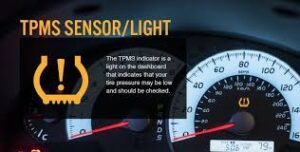Blog
The Role of TPMS in Road Safety
The Role of TPMS in Road Safety
Road safety is a top priority for every driver, and maintaining proper tire pressure plays a crucial role in achieving it. The Tire Pressure Monitoring System (TPMS) is a technology designed to ensure tires are inflated to their optimal levels, improving vehicle performance, fuel efficiency, and, most importantly, safety. This article explores how TPMS contributes to road safety and why it’s an essential feature for modern vehicles.
Understanding TPMS
A Tire Pressure Monitoring System monitors the air pressure in your vehicle’s tires. When the pressure falls below or exceeds the recommended range, the TPMS alerts the driver via a dashboard warning light or message.
There are two main types of TPMS:
- Direct TPMS: Uses sensors in each tire to measure pressure accurately.
- Indirect TPMS: Estimates pressure by analyzing wheel rotation speeds through the Anti-lock Braking System (ABS).
Both systems aim to maintain proper tire pressure and prevent accidents caused by underinflation or overinflation.
The Connection Between Tire Pressure and Safety
1. Improved Vehicle Stability
Proper tire pressure ensures optimal traction and handling. Underinflated or overinflated tires can compromise stability, increasing the likelihood of skidding, especially on wet or uneven roads.
2. Enhanced Braking Performance
Tires with correct pressure maintain better contact with the road, ensuring shorter braking distances. Underinflated tires reduce this contact, leading to longer stopping times and increased risks in emergencies.
3. Reduced Blowout Risk
Low-pressure tires flex excessively, generating heat and weakening their structure. This increases the chances of blowouts, which can result in loss of control at high speeds.

How TPMS Enhances Road Safety
1. Real-Time Pressure Monitoring
TPMS provides instant alerts when tire pressure deviates from the safe range, allowing drivers to take immediate action and prevent accidents.
2. Early Detection of Slow Leaks
Small punctures or valve issues can lead to gradual air loss, often unnoticed until it becomes dangerous. TPMS identifies these leaks early, giving drivers the chance to address the problem before it escalates.
3. Alerts for Temperature Changes
Some advanced TPMS systems also monitor tire temperature. Since temperature affects pressure, these systems ensure that tires remain safe under changing weather or driving conditions.
4. Minimized Risk of Hydroplaning
Properly inflated tires disperse water more effectively, reducing the risk of hydroplaning during rain. TPMS helps maintain optimal pressure for better water clearance and road grip.
TPMS and Fuel Efficiency
Maintaining the correct tire pressure not only enhances safety but also improves fuel efficiency:
- Underinflated tires increase rolling resistance, causing the engine to work harder and consume more fuel.
- TPMS ensures tires stay at the optimal pressure, reducing fuel consumption and saving costs.
Legal Requirements and TPMS
In many countries, TPMS is a mandatory safety feature in vehicles:
- United States: TPMS has been required in new vehicles since 2007, following the TREAD Act.
- European Union: Since 2014, all new cars sold in the EU must have TPMS installed.
These regulations highlight the importance of TPMS as a critical safety tool.

Maintaining Your TPMS for Safety
To ensure your TPMS operates effectively:
- Inspect Sensors Regularly: Check for damage or wear on TPMS sensors during tire maintenance.
- Recalibrate After Tire Changes: Reset the system after rotating or replacing tires to ensure accurate readings.
- Replace Sensor Batteries: Most TPMS sensors have a battery life of 5–10 years. Replace them as needed.
- Pair TPMS with Manual Checks: While TPMS is reliable, regular manual pressure checks provide an added layer of safety.
Beyond the Driver: TPMS and Road Safety for All
TPMS doesn’t just protect the driver; it contributes to overall road safety by:
- Reducing accidents caused by tire failure.
- Preventing debris from blown tires, which can endanger other motorists.
- Lowering the likelihood of sudden stops or loss of control that disrupt traffic flow.
Future of TPMS in Road Safety
As automotive technology advances, TPMS systems are becoming more sophisticated:
- Integration with Smart Vehicles: Connected cars can send TPMS data to your smartphone or service centers.
- Predictive Analytics: Advanced TPMS can predict potential issues based on pressure trends and driving habits.
- Enhanced Accuracy: Innovations in sensor technology continue to improve the reliability of TPMS.
Final Thoughts
The Tire Pressure Monitoring System (TPMS) is a vital component of modern vehicle safety. By ensuring proper tire pressure, it helps prevent accidents, improves fuel efficiency, and extends tire life. Maintaining your TPMS and understanding its role in road safety can make every journey safer for you and others on the road.
Stay informed and stay safe with expert tips from RegalXmuse.com—your trusted source for automotive insights.


